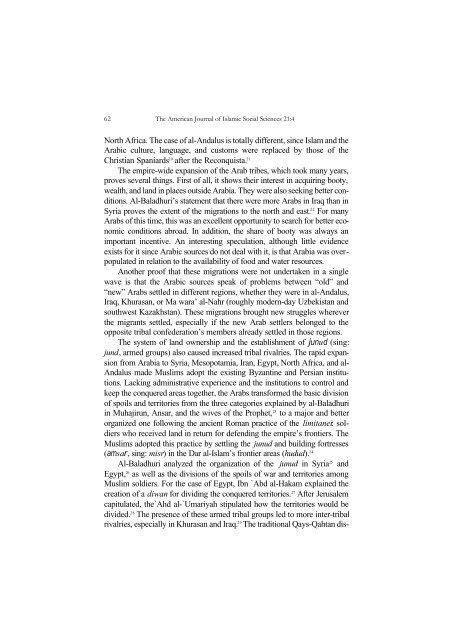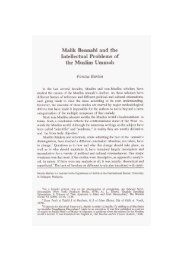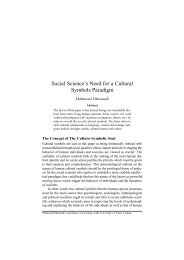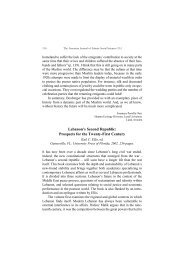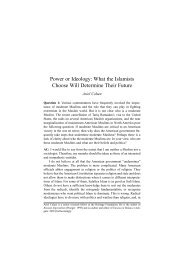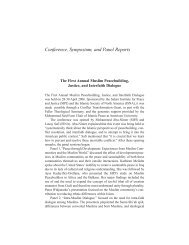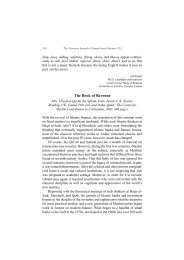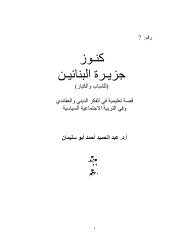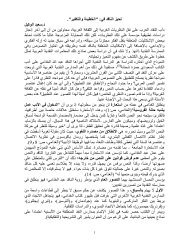Arab Tribes, the Umayyad Dynasty, and the `Abbasid ... - Epistemology
Arab Tribes, the Umayyad Dynasty, and the `Abbasid ... - Epistemology
Arab Tribes, the Umayyad Dynasty, and the `Abbasid ... - Epistemology
You also want an ePaper? Increase the reach of your titles
YUMPU automatically turns print PDFs into web optimized ePapers that Google loves.
62 The American Journal of Islamic Social Sciences 21:4<br />
North Africa. The case of al-Andalus is totally different, since Islam <strong>and</strong> <strong>the</strong><br />
<strong>Arab</strong>ic culture, language, <strong>and</strong> customs were replaced by those of <strong>the</strong><br />
Christian Spaniards 20 after <strong>the</strong> Reconquista. 21<br />
The empire-wide expansion of <strong>the</strong> <strong>Arab</strong> tribes, which took many years,<br />
proves several things. First of all, it shows <strong>the</strong>ir interest in acquiring booty,<br />
wealth, <strong>and</strong> l<strong>and</strong> in places outside <strong>Arab</strong>ia. They were also seeking better conditions.<br />
Al-Baladhuri’s statement that <strong>the</strong>re were more <strong>Arab</strong>s in Iraq than in<br />
Syria proves <strong>the</strong> extent of <strong>the</strong> migrations to <strong>the</strong> north <strong>and</strong> east. 22 For many<br />
<strong>Arab</strong>s of this time, this was an excellent opportunity to search for better economic<br />
conditions abroad. In addition, <strong>the</strong> share of booty was always an<br />
important incentive. An interesting speculation, although little evidence<br />
exists for it since <strong>Arab</strong>ic sources do not deal with it, is that <strong>Arab</strong>ia was overpopulated<br />
in relation to <strong>the</strong> availability of food <strong>and</strong> water resources.<br />
Ano<strong>the</strong>r proof that <strong>the</strong>se migrations were not undertaken in a single<br />
wave is that <strong>the</strong> <strong>Arab</strong>ic sources speak of problems between “old” <strong>and</strong><br />
“new” <strong>Arab</strong>s settled in different regions, whe<strong>the</strong>r <strong>the</strong>y were in al-Andalus,<br />
Iraq, Khurasan, or Ma wara’ al-Nahr (roughly modern-day Uzbekistan <strong>and</strong><br />
southwest Kazakhstan). These migrations brought new struggles wherever<br />
<strong>the</strong> migrants settled, especially if <strong>the</strong> new <strong>Arab</strong> settlers belonged to <strong>the</strong><br />
opposite tribal confederation’s members already settled in those regions.<br />
The system of l<strong>and</strong> ownership <strong>and</strong> <strong>the</strong> establishment of junud (sing:<br />
jund, armed groups) also caused increased tribal rivalries. The rapid expansion<br />
from <strong>Arab</strong>ia to Syria, Mesopotamia, Iran, Egypt, North Africa, <strong>and</strong> al-<br />
Andalus made Muslims adopt <strong>the</strong> existing Byzantine <strong>and</strong> Persian institutions.<br />
Lacking administrative experience <strong>and</strong> <strong>the</strong> institutions to control <strong>and</strong><br />
keep <strong>the</strong> conquered areas toge<strong>the</strong>r, <strong>the</strong> <strong>Arab</strong>s transformed <strong>the</strong> basic division<br />
of spoils <strong>and</strong> territories from <strong>the</strong> three categories explained by al-Baladhuri<br />
in Muhajirun, Ansar, <strong>and</strong> <strong>the</strong> wives of <strong>the</strong> Prophet, 23 to a major <strong>and</strong> better<br />
organized one following <strong>the</strong> ancient Roman practice of <strong>the</strong> limitanei: soldiers<br />
who received l<strong>and</strong> in return for defending <strong>the</strong> empire’s frontiers. The<br />
Muslims adopted this practice by settling <strong>the</strong> junud <strong>and</strong> building fortresses<br />
(amsar, sing: misr) in <strong>the</strong> Dar al-Islam’s frontier areas (hudud). 24<br />
Al-Baladhuri analyzed <strong>the</strong> organization of <strong>the</strong> junud in Syria 25 <strong>and</strong><br />
Egypt, 26 as well as <strong>the</strong> divisions of <strong>the</strong> spoils of war <strong>and</strong> territories among<br />
Muslim soldiers. For <strong>the</strong> case of Egypt, Ibn `Abd al-Hakam explained <strong>the</strong><br />
creation of a diwan for dividing <strong>the</strong> conquered territories. 27 After Jerusalem<br />
capitulated, <strong>the</strong>`Ahd al-`Umariyah stipulated how <strong>the</strong> territories would be<br />
divided. 28 The presence of <strong>the</strong>se armed tribal groups led to more inter-tribal<br />
rivalries, especially in Khurasan <strong>and</strong> Iraq. 29 The traditional Qays-Qahtan dis-


